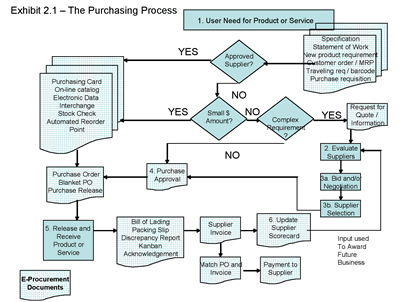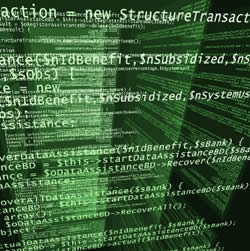
EDI is the process of exchanging business data from one computer to another in an agreed upon standard format, and was the first form of e-commerce to be widely used in business; 20 years before the term existed. The two main uses of EDI are for the exchange of transaction data, price quotes, and order status updates. The data found in the B2B transactions comes from information usually found on the following forms:
- paper invoices
- purchase orders
- requests of quotation
- bills of lading
- receiving reports.
The data found on these five forms accounts for more than 3/4 of all data exchanged by trading partners in the US.
Some of the reasons to become familiar with EDI include:
- Most B2B e-commerce is an adaptation to or based on EDI principles;
- EDI is the most used method of B2B e-transactions. The dollar amount of all EDI transactions in '08 equalled the total dollar amount of all other B2B transactions.
Early Efforts and Emergence of Broader Standards
Here is a timeline of the early eforts at business data interchange:
- Late 1800s-early 1900s: Emergence of large businesses bring about need to create formal records of business transactions.
- 1918: THe ANSI forms to coordinate standards in the US.
- The organization does not create standards, but rather created a set of procedures that are used to develop national standards and also accredits commites that follow these procedures.
- 1950s: Companies begin using computers to store and process transactions performed in-house; information flow between businesses is still paper-based.
- 1960s: Punch cards and magnetic tape begin to make processes more automated.
- 1968: Transportation Data Coordinating Committee forms to explore ways to reduce paperwork involved in the transaction processes.
- This organization was formed out of a number of freight and shipping companies, and created a set of standards that included all the elements most used by shippers, allowing for the shippers to convert this information to a computer file, reducing the amout of paperwork involved.
- The benefits of these standards were only noticed by companies that complied with them, which led to the realization of the effeciency of EDI standards that would be univeral for all companies.
- 1970s: Use of telephones improves B2B information interchange greatly.
- 1979: The ASCX12 formed to develop uniform EDI standards.
- The standard currently includes hundreds of transaction sets, or the names of the formats for specific business data interchanges.
- One downside to these standards was the fact that although they were being used in the US, companies that were overseas were using their own standards.
- The ASC X12 activities are coordinated by the DISA.
- 1987: The UN publishes the EDIFACT or UN/EDIFACT, a set of standards that are able to be used worldwide.
- Many of the standards included are similar to those found in the ASC X12 transaction sets
- 2000: The ASC X12 and UN/EDIFACT agreed to form one common standard set, but as of now nothing has occured and no date has been set.
Although the basic ideas behind EDI are straightforward, implementing them can be difficult, even in the simplest of business situation. There are two main methods of information flow: paper-based and EDI-based. The processes for each are described below.
Paper-Based Purchasing Process

As you can see, the paper-based purchaseprocess is not just long, but can get cumbersome, but when companies use EDI, it makes things a whole lot easier, as you well see below.

As you can tell, EDI reduces paperflow and stremalines information flow in businesses. There are two forms of EDI, direct and indirect connection. Direct connection EDI involves each business operating a EDI translator computer on-site, then connecting to it through modems and telephone or dedicated leased lines. Both types of lines come with their own problems. Since telephone lines are a problem when the customers or vendors are in different time zones and are processing a transaction that is either time sensitive or high volume, and leased lines can become quite expensive when used for many connections. Another complication may arise if trading partners do not use the same communication protocols.
If this option does not work, a business can use a VAN to aid in the process. To do this, The customer connects to the VAN and forwards the EDI message to the VAN. This message is then sent to the trading partner's e-mail, which is then accessed by the trading partner logging into the VAN and receiving the message. This is called indirect connection EDI due to the fact that the message is not sent straight to the trading partner, but rather through a VAN and then the trading partner.
Some of the advantages of using a VAN over a direct connection include:
- The need to support only the communications protocol used on the VAN, rather than the many possible protocols used by each trading partner;
- The VAN uses an audit log to record message activity, which can be useful in resolving disputes;
- The VAN can translate one transaction set to another;
- The VAN can check that the transaction set being used is in an EDI format.
The main disadvantage of the use of VANs is the cost. Those companies that only perform a few transactions rarely can justify the costs involved for the use. Also, it can be problematic for usinesses that want to work with trading partners that use different VANs, since the cost of this service is often not fixed.
EDI can be used to provide instructions to the bank used by a trading partner; this process is similar to the use of a check, since a check instructs a bank to transfer a stated amount of money from one account to another. This is also called EFT, or electronic funds transfer. When EFT is between two banks, the service used is an ACH, or automated clearing house. Banks can use one of two options, either the federal ACH, or a private ACH.

EDI on the Internet: Internet/Web/Open EDI
The use of EDI with Internet technologies has allowed for major improvements in business communications, but at the same time has come with its own set of problems. One of the biggest possible problems that businesses encounter when deciding to use the Internet to conduct EDI is the matter of security; however, there are many ways that businesses can make the process secure without being too cost-intensive.
One of the significant aspects of EDI is nonrepudiation, or the ability to establish that a transaction has occured. It prevents both parties involved in a transaction from denying that a transaction is valid or even exists.
As much as Internet EDI has grown, it has not replaced the traditional EDI standards due to the fact that many companies have made significant investments in technology used primarily for EDI.

There are multiple advances being made in the integration fo EDI and the internet. One of those is the use of XML to allow businesses to be more flexible in their data information interchanges. One form of standards in development is ebXML, which is still being refined. Another is the practice of companies allowing trading partners to access their networks, making it an extranet. This is allowing for companies to make sure that customers are not making returns of products that were not purchased in the first place, as is the case with Nintendo that is discussed in the book.